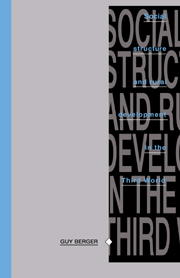3 - Capitalism and underdevelopment
Published online by Cambridge University Press: 17 September 2009
Summary
Centre and periphery in the international capitalist system
Having looked in detail in the previous chapter at the CMP and its relation to labour processes, I now turn to the relation of the CMP to the international economy. The dependency approach is to conflate the two units. Thus, the dependence of diverse producers on the market is seen to link them together as participants in a global CMP (see Wallerstein, 1974: 77; Frank, 1969a, 1969b). Clearly, however, this view detracts from the particularities of the articulation of capitalist production with external non-capitalist relations. Differences between the ‘trees’, so to speak, are hidden by their intertwined foliage. The dependency approach cannot properly explain why – if it is the CMP that characterises First and Third World alike – the two are so different economically (Roxborough, 1976: 119–20). As Dos Santos (1969: 75) asks about the Third World, ‘is it a particular case of capitalism, a completely different mode of production, or a system in transition towards capitalism?’
Indeed, such have been the differences between developed and underdeveloped social formations that some writers have seen the latter as exhibiting a mode of production sui generis. Thus, if the one extreme is to identify the international capitalist economy with the capitalist mode of production, its mirror opposite locates modes of production at the same unit of analysis as social formations.
- Type
- Chapter
- Information
- Publisher: Cambridge University PressPrint publication year: 1992



